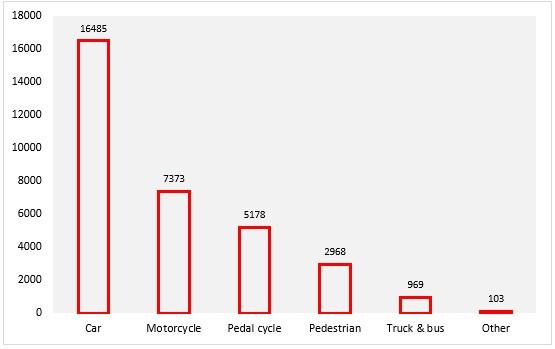
Public concern at the number of road-related fatalities is important given there were 1,193 road-related deaths in Australia in 2013, including 50 cyclists, 157 pedestrians, 215 motorcycle riders and 766 motor vehicle occupants.
It’s not the complete picture, though. Many more travellers suffer injuries – some very serious – in road crashes. In 2010-11, more than 33,000 people injured in road crashes were admitted to hospital in Australia. (1)
While the great majority make a full and relatively quick recovery, some are much less fortunate. Given they don’t have the benefit of seat belts or air bags, pedestrians are especially vulnerable to serious injury.
This article from the New York Times, Struck on the street: four survivors, indicates that the physical and emotional damage to pedestrians who survive being struck by a car can have long-lasting effects.
Motorcycle and bicycle riders are especially vulnerable too. Earlier this year six cyclists in Sydney were seriously hurt after being struck from behind by a car. Fortunately none of them were killed but three suffered major back injuries, one a fractured elbow, and another severe lacerations.
The exhibit shows the number of patients who were formally admitted to a hospital in Australia in 2010-11 with a road-related injury. It’s taken from a report, Trends in hospitalised injury 1999-00 to 2010-11, published last year by the Australian Institute of Health and Welfare.
There’s no information on the length of stay or severity of injury for patients admitted as the result of a road crash. However the report also looks at other causes of injuries e.g. self-harm, poisoning, assault, falls.
The author notes the average stay due to all causes of injury was 4 days and that one in six injuries was classified as posing a high threat to life. Given falls account for a very large proportion of all injury admissions, it seems plausible road injuries would be at least as severe as the average.
So far as road-related injuries are concerned, occupants of cars account for 49.8% of the nation’s hospital admissions. That’s much lower than the 80.1% mode share of passenger cars in Australia’s capital cities. (2)
It contrasts sharply with two wheelers. Motorcycle riders make up 22.3% of road-related hospitalisations even though they account for less than 1% of capital city travel.
It’s hard to get reliable data on the mode share of bicycles, but it’s probably even smaller than that of motorcycles. Yet cyclists comprise 15.7% of road crash admissions.
The absolute numbers are sobering too. In 2010-11, 16,485 car occupants and 2,968 pedestrians were admitted to hospital as a result of road crashes. Given their miniscule mode share, the numbers for two wheelers are especially alarming; 7,373 motorcycle riders and 5,178 cyclists. (3)
The report doesn’t have data on causes, but we know from other sources (e.g. here and here) that collisions with cars, trucks and buses are a key cause of injuries to pedestrians and riders. The latter are injured on roads in other ways too e.g. spills, skids, collisions with objects, running off the road. Rider behaviour is a contributory factor as well.
Reducing injuries and fatalities for occupants of cars is of course an important objective (see Can we make our roads as safe as Sweden’s?). Many of the gains in safety made over the last 40 or so years have come from improvements in in-vehicle technology, most notably seat belts.
However there are fewer “easy fixes” for pedestrians and riders. While it would be unreasonable to say they’ve been ignored completely, their welfare has generally played second fiddle to the objective of engineering and regulating roads to facilitate the movement of vehicles.
The shocking numbers of injuries suffered by these groups can’t be reduced by in-vehicle technology. A significant reduction in casualties will partly require different behaviours (particularly some motorcycle riders), but it will mostly require policy-makers to design roads and rules that are more accommodating of vulnerable road users.
__________________________________________
-
If Non-Traffic (i.e. off-road) and Unspecified cases are included, there were 50,775 hospital admissions for transport-related injuries in Australia in 2010-11.
-
Share of motorised modes in capital cities based on kilometres of travel, BITRE Year Book 2013: Infrastructure statistics 2013.
-
Two wheel users also suffer high rates of injury when riding on footpaths, bike paths, bush trails, private property, etc. A further 5,345 motorcyclists and 3,657 cyclists were admitted to hospital with injuries suffered off-road; that’s much higher than the off-road figures for car occupants (1,125) and pedestrians (795).








Crikey is committed to hosting lively discussions. Help us keep the conversation useful, interesting and welcoming. We aim to publish comments quickly in the interest of promoting robust conversation, but we’re a small team and we deploy filters to protect against legal risk. Occasionally your comment may be held up while we review, but we’re working as fast as we can to keep the conversation rolling.
The Crikey comment section is members-only content. Please subscribe to leave a comment.
The Crikey comment section is members-only content. Please login to leave a comment.